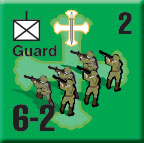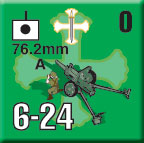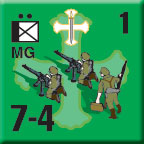| Golden Journal No. 64
Russian Imperial Guard
Publisher’s Preview
by Mike Bennighof, Ph.D.
August 2024
I’m not sure what other wargame publishers take as their model, but at Avalanche Press we usually follow the very old, well-tried “core-supplement” pattern. There’s a game that has everything you need to play, and then expansions so you can keep playing it for many years after you first enjoyed it. New pieces, new scenarios to freshen up and old favorite and make it new again.
The Golden Journal is the designer’s playground (which means me), and we’ve mostly covered topics that reflect my alt.history whims. Golden Journal No. 64: Russian Imperial Guard is a little different than most Journals; it’s strictly a historical approach, with ten scenarios from the October 1914 Battle of Warsaw (also called the Battle of the Vistula, to distinguish it from all the other Battles of Warsaw; the Russians called it the Warsaw-Ivangorod Operation).
So far, almost all of Infantry Attacks has been set on the Eastern Front in 1914, because that’s what I know about and it’s what interests me. I like the way the games and expansions have turned out, and though we’ll move to other fronts with Devil Dogs and Palestine, the early months on the Eastern Front remain my prime interest. That makes Russian Imperial Guard a natural extension.
 It’s also an opportunity to look more at the Russian side of things, as books like Franz Josef’s Armies and Edelweiss Division have been heavily Austro-centric in terms of their background material. And I’m fine with that, because that’s what I wanted to write. We delve more into the Russian Army in the Fortress Przemyśl book, but in Imperial Russian Guard, it’s all about the Battle of Warsaw and the Imperial Guard (there’s only so much space in a Golden Journal). Like the Battles of Kraśnik and Komarów (seen in Fall of Empires and Franz Josef’s Armies) and Limanowa (the theme of Edelweiss Division), we’re talking about nearly one million men operating over a span hundreds of kilometers. So our focus is on the Imperial Guard; the Guard Corps fought on the northern flank of the great battle, facing off against the Germans and the 3rd Guards Division on the opposite flank, against the Austro-Hungarians. It’s also an opportunity to look more at the Russian side of things, as books like Franz Josef’s Armies and Edelweiss Division have been heavily Austro-centric in terms of their background material. And I’m fine with that, because that’s what I wanted to write. We delve more into the Russian Army in the Fortress Przemyśl book, but in Imperial Russian Guard, it’s all about the Battle of Warsaw and the Imperial Guard (there’s only so much space in a Golden Journal). Like the Battles of Kraśnik and Komarów (seen in Fall of Empires and Franz Josef’s Armies) and Limanowa (the theme of Edelweiss Division), we’re talking about nearly one million men operating over a span hundreds of kilometers. So our focus is on the Imperial Guard; the Guard Corps fought on the northern flank of the great battle, facing off against the Germans and the 3rd Guards Division on the opposite flank, against the Austro-Hungarians.
The battle itself saw the newly-formed German Ninth Army advance on Warsaw, with Paul von Hindenburg in titular command but the army’s chief of staff, Erich Ludendorff, exercising actual control as Hindenburg had also taken over as overall commander of German forces on the Eastern Front. The Germans (and the Austro-Hungarian First Army on their right flank) became over-extended by the time they reached the line of the Vistula River. And that’s where the Russians struck back.
 The counter-offensive, actually a badly delayed offensive scheduled before the Germans began their advance, caught the German Ninth Army spread out and unprepared for offer a coherent defense. By the end of October, the Russians had rolled the Germans back to the pre-war border, inflicting 150,000 casualties on them but at the cost of at least that many of their own. All of this occurred in unseasonably heavy mud. The counter-offensive, actually a badly delayed offensive scheduled before the Germans began their advance, caught the German Ninth Army spread out and unprepared for offer a coherent defense. By the end of October, the Russians had rolled the Germans back to the pre-war border, inflicting 150,000 casualties on them but at the cost of at least that many of their own. All of this occurred in unseasonably heavy mud.
Daily Content includes no AI-generated content or third-party ads. We work had to keep it that way, and that’s a lot of work. You can help us keep things that way with your gift through this link right here.
The defeat humiliated the German leadership, who had been basking in their victories at Tannenberg and the Masurian Lakes. Ludendorff would make ludicrous excuses for the German failure; supposedly he had wanted the Russians to cross the river, so that the Germans and Austrians could attack their bridgeheads, but the Austrians failed to follow through. He would take no blame for the failure, as it would be forgotten in the wake of the inconclusive battle of Lodz two weeks later, which the Germans claimed as a victory.
 The Imperial Guard at this point formed almost an army of its own, though they were not yet operating together (that would come soon enough). The Guards Corps of two divisions fought with the Russian Fourth Army at Krasnik against the Austro-Hungarian First Army, along with Separate Guards Cavalry Brigade commanded by Carl Gustav Mannerheim (yes, the Finnish marshal). The 3rd Guards Infantry Division at the war’s beginning served in XXIII Army Corps in Second Army, avoiding the cauldron at Tannenberg, and fought on the Vistula. The Guards Cavalry Corps of two divisions served with First Army in East Prussia. And finally, the separate Guards Rifle Brigade fought with Ninth Army against the Austrians in Galicia and also participated in the Warsaw-Ivangorod Operation. The Imperial Guard at this point formed almost an army of its own, though they were not yet operating together (that would come soon enough). The Guards Corps of two divisions fought with the Russian Fourth Army at Krasnik against the Austro-Hungarian First Army, along with Separate Guards Cavalry Brigade commanded by Carl Gustav Mannerheim (yes, the Finnish marshal). The 3rd Guards Infantry Division at the war’s beginning served in XXIII Army Corps in Second Army, avoiding the cauldron at Tannenberg, and fought on the Vistula. The Guards Cavalry Corps of two divisions served with First Army in East Prussia. And finally, the separate Guards Rifle Brigade fought with Ninth Army against the Austrians in Galicia and also participated in the Warsaw-Ivangorod Operation.
The Guards attracted ambitious young nobles to the officer corps, with the cavalry having the highest prestige. At the very least, this offered postings to St. Petersburg and Warsaw rather than Irkutsk or Vologda. At its very best, a young Guards officer had access to the Empire’s highest social circles.
The rank-and-file came from the conscription pool, selected for their appearance: a handsome face (draft boards had a whole rating system to identify Guards recruits) came first; men were then assigned to particular regiments based on height and hair color. None of these qualifications pointed to a particular fighting ability, but fanatic loyalty to the Tsar had been instilled and the Guards proved to be stubborn in attack and defense.
 The Grenadier Corps, which also saw heavy action on the Vistula, was not an elite formation; “Grenadier” was merely an honorific attached to eight infantry regiments raised in Moscow. The Grenadier Corps, which also saw heavy action on the Vistula, was not an elite formation; “Grenadier” was merely an honorific attached to eight infantry regiments raised in Moscow.
Since this is a Golden Journal, you also get 24 Imperial Guard pieces in their own special Guards livery. Strictly speaking, you don’t need these pieces to play the scenarios. It’s just more fun to use the special pieces. They’re die-cut and silky-smooth, just like the ones in our games. They’ve been spared the crushing hammer-blow of the last-century’s die-cutting process, so you don’t have a horse-trough slammed into the back side of the piece – they’re so smooth, we have to put a tiny stripe across the back, else you won’t know which side is which.
What we have here is a historical Campaign Study, and 24 ultra-cool Guard pieces to go with it. You get ten new scenarios in two chapters, with both sides getting to attack and defend as the Russian launch their offensive and the Central Powers try to shove them back into the Vistula.
The Golden Journal is only available to the Gold Club (that’s why we call it the Golden Journal).
Click here to join the Gold Club.
See your Gold Club Insider newsletter for ordering information.
Sign up for our newsletter right here. Your info will never be sold or transferred; we'll just use it to update you on new games and new offers.
Mike Bennighof is president of Avalanche Press and holds a doctorate in history from Emory University. A Fulbright Scholar and NASA Journalist in Space finalist, he has published a great many books, games and articles on historical subjects; people are saying that some of them are actually good.
He lives in Birmingham, Alabama with his wife, three children, and new puppy. He misses his lizard-hunting Iron Dog, Leopold.
Daily Content includes no AI-generated content or third-party ads. We work had to keep it that way, and that’s a lot of work. You can help us keep things that way with your gift through this link right here.
|
